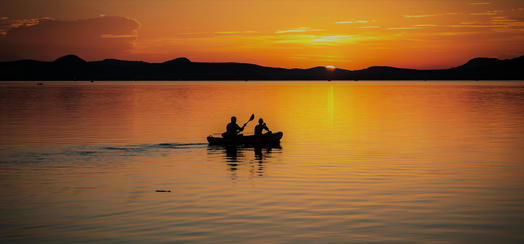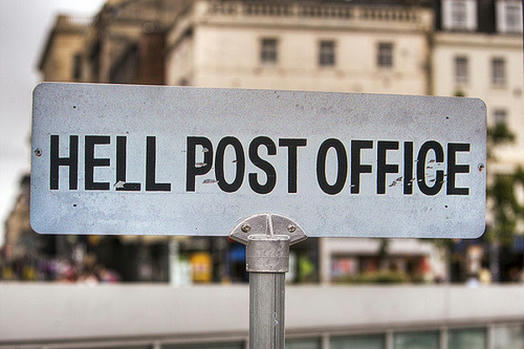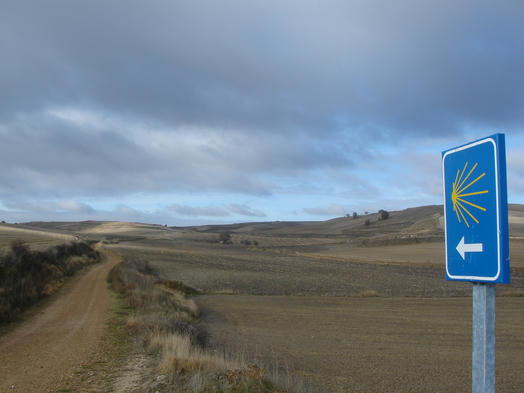It was not the ruins of Machu Picchu, nor the mysterious pictures of the Nasca Desert that drove me to Peru. It was rather the green fields of coca and the mixed aura of danger and adventure Peru projected.
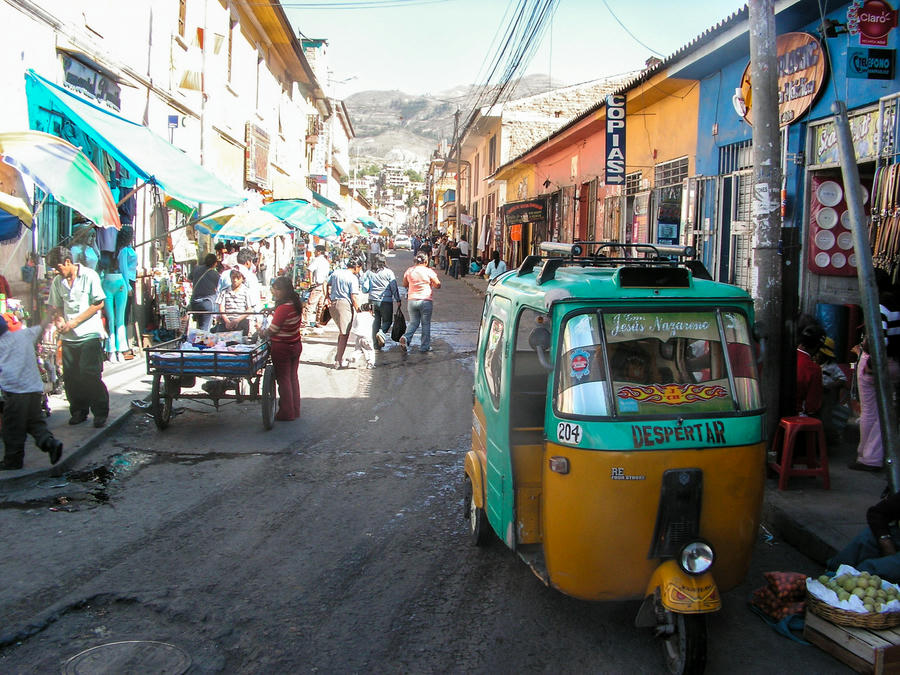
No pasaran!
In the 2000s, a pro-communist and anti-government paramilitary group Cendero Luminoso controlled the region of Ayacucho. Its capital Ayacucho was brought back under the reign of the government only recently. Still, the atmosphere was far from being peaceful: During the one and a half month I spent here in 2007, I witnessed several protests - from the many protests that were held in Peru back then. The strike of the teachers was one of the most violent ones: The demonstrators broke windows, police spread tear gas, all the shops closed down for two days and all the public transport went on strike. The main reason was the ongoing privatization of schools. The expected outcome of the privatization was a monthly fee of 12 USD per child – a sum too high for many families. Groups of protestors carried coffins with the name of the president Alan Garcia on them and posed with tourists before setting the coffins on fire.
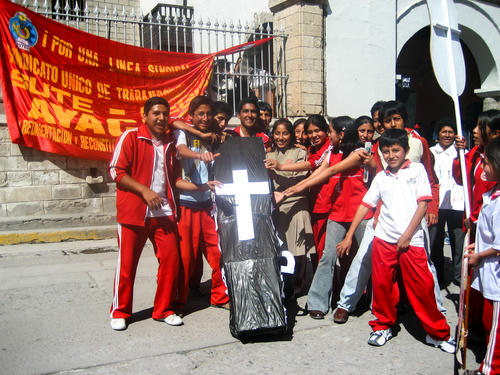

The buses that were heading to Ayachucho stopped on the highway a couple of miles away from city. Travelers were expected to walk the rest as taxis and tuk-tuks were on strike. It was great luck to find an apolitical peasant who could transport your suitcase on his bike or on a donkey’s back.
The doctors’ strike affected me even more. Unluckily, one backpacker I met in Ayacucho got bitten by a dog. The only help she could get was a piece of advice: to search for the dog and make sure it hasn’t got rabies. And if it has, to book the first flight back home. So there we were, knocking on every door of the neighbourhood where the accident took place, asking people to show us their dogs. Soon, we were joined by a gang of local children who eagerly shared information about the biting dogs of the block. In spite of our fears and the questionable tactic, the dog was found and the issue was solved.
"Chew more coca, leave less for drug producers"
One of the days when the market was not closed, I was doing my grocery shopping. Among numerous sorts of bananas and potatoes, I spotted dry leaves, resembling bay.
“Coca, gringitas”, the old lady who was selling the leaves whispered confidentially and my heart jumped. Soon, I got a plastic bag, fully stuffed with coca leaves for an equivalent of $1.
At my hostel, I tried to make my first mate de coca with the help of a hostel receptionist. Making mate de coca was actually as easy as it gets: you just have to pour boiling water over the leaves and wait a couple of minutes.
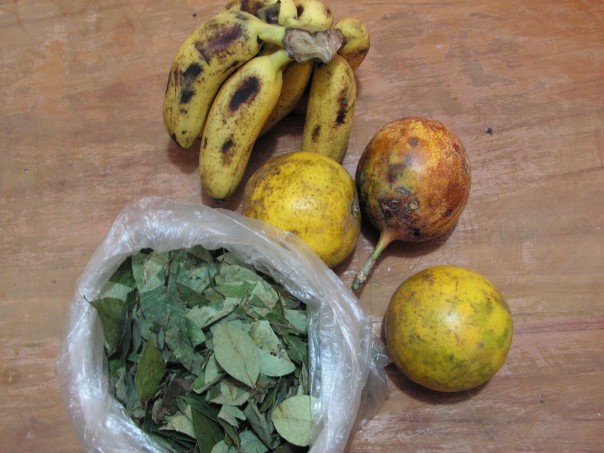
That day, I found mate to be quite disagreeable. However, my love for this drink grew with every cup, and at the end of my Peruvian trip, I opted for bringing coca leaves as souvenirs back home – in lieu of dull Peruvian flutes and knitted hats with llama patterns.
The hostel receptionist turned out to be the right person to refer to in regards to issues with coca leaves – his parents owned a farm growing coca in the region of the Valley of Rio Apurimac – a tributary of the Amazon.
From the stories which he told me it got clear that the farm was struggling to meet both ends meet. Till the 1970ies they were cultivating coffee there, then the price of coffee plummeted, it was impossible to get more than $1 for a kilogram of coffee beans. All efforts to introduce other species failed – the plants were not growing, and if they were, they were not selling, and if they were selling, it literally for cents. Who was buying the harvest of the coca farm, that was the question I was interested in, but even then I decided to stay silent on that subject.
Having noticed my interest in his farm, the hostel receptionist suggested that he could actually take me there the next time he goes home – extra working hands will always be appreciated. That’s how I became the coca leaves trimmer.
The Jungle Camp
The valley of Apurimac River was exactly the place, my guide book insisted tourists shall not visit. Just like some other regions of the Amazon selva, it was not entirely controlled by the government. There were certain periods of time when the roads leading to the western side of the Andes got closed for days or weeks as a result of ‘anti-terrorist operations’.
Once again, I decided to act against the recommendations of my guide book. After the 6,5 hours, it took the bus to cover the 192 km between Ayacucho and San-Francisco, I was in the Peruvian rainforest. The road conditions between both towns is a topic worth a separate blog post – or actually better suited for the format of a thriller/horror movie.

This Top Gear episode about Bolivia's Death Road gives a good idea about some parts of the road from Ayacucho to San Fransisco
From San-Francisco we were supposed to take a taxi collective, a ‘collective taxi’, these taxis left when they were full, and they were regarded as such when 6 people were squeezed into a car: 2 people on the front seat next to the driver and 4 people placed on the 3 seats in the back. In the end, my trip to the farm turned out to be more exciting than the stay at the farm itself. Work in the field consisted of cutting leaves and letting them dry on a tarp.
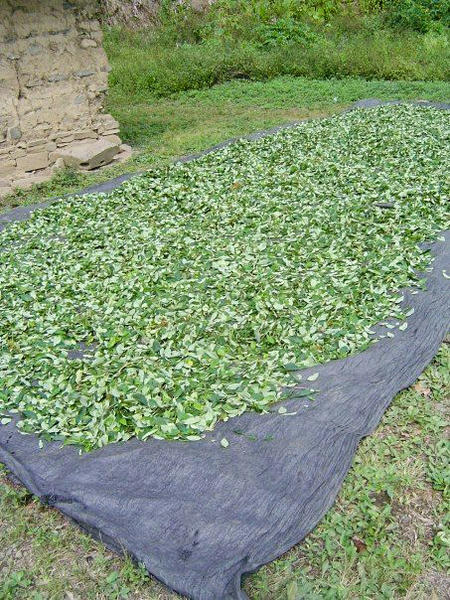

Way more promising was meeting a local shaman. He just ran into me as I was on my way to see the nearby Pichari Waterfalls and suggested keeping me a company. The first part of the way to the Waterfalls was to be done by another collective taxi, the second part of the trip crossed through the jungle and had to be done on foot. My new acquaintance stopped in the villages we walked through to sell his hand-made jewellery. But the jewellery business was only a cover, he told me. What he really did for life was being a shaman and his main clients were the drug mafia people. I carefully asked if it was not dangerous, his field of work.
“Not at all, indeed”, the shaman replied. “My occupation is of the safest kind in Peru. Everybody thinks that I am almighty and is afraid of me, while in reality, I may only make somebody a bit sick at best.”
“Mami, if you ever happen to have any problems, just say that you know Miguel” he concluded.
I nodded without being convinced, pondering how many Miguels may live in Peru.
Soon, we reached the waterfalls, where my company claimed the presence of the negative energy of selva. He insisted that he should fumigate me in order to protect me from it. Fumigating was executed with a regular cigarette. I was trying to show with my critical air what I thought of the performed ritual. Miguel just ignored my reaction and emphasized that I was going to get some sickness in case I was not fumigated properly. Thinking of the malaria I got when I came back from selva, he turned out to be right. I should have put more trust in his magic or, probably better, in those anti-malaria pills one should take before going to the jungle of Peru. Taking into account the general doctors’ strike, getting malaria was no good at all.
But it was neither fumigating nor my mocking of it that shaped my memory of this day: we had a lovely time at the waterfall. A sweet black puppy suddenly appeared out of nowhere and even followed us on our way back to the village. Miguel called it Angela after the waterfall we found her at. He announced to me that the puppy chose us and from then on the puppy was mine.
But adopting a dog was not the most daring of Miguel`s offers. He suggested that the three of us should walk through the jungle to the ruins of Machu Picchu, he apparently knew the path through the jungle and could lead me there in just two days. It might have been the best time of my life and the biggest adventure ever but my sense of self-protection (that is normally sleeping like Sleeping Beauty under a spell) woke up this time. The kind offer was rejected. Angela was left behind at the taxi collectivo station.
On the way back from San Francisco to Ayacucho, our van was stopped a couple of times by the police. Apparently, these types of controls are normal for all the cars leaving the region. Not to waste time, our enterprising driver handed the police notes hidden in the car’s papers and we moved on without any delays.

Coca, the health benefits of
Before leaving San Francisco for Ayacucho, I found a poster of the International Coca Festival. Unfortunately, I had already missed it. According to the poster, guests from Columbia, Ecuador and Bolivia were expected to participate in a parade and take part in different competitions. One competition impressed me the most –“who would chew the most beautiful ball of coca leaves?” was its title.
You chew coca leaves in the following manner: take a small portion of the leaves and a bit of tocra that works as a catalyzer.
Chewing coca leaves is supposed to be beneficial and reduce fatigue, hunger, combat altitude sickness and improve the general state of health. Together with the people I met at the hostel, I decided to do an experiment. Its aim: to prove empirically the benefits of chewing coca leaves on the body. Materials: four backpackers, one guide, coca leaves, tocra – the bark of an Amazon selva tree. Procedure: The experiment’s participants went on a day trip to Bosque de Piedras – a scenic place located close to Ayacucho. The participants were divided into two groups and set out on a path to a deep blue Andean lake.The first group chewed coca while ascending. The second group was walking up the hill without chewing anything.
Results: The first group was walking faster. The second group lacked breath and having reached the car, declined the option of descending the mountain on foot.


That evening, we were coming back to Ayacucho with a bit of romance. This time, it was our driver who made the trip memorable. At first, he gave a ride to his fiancé and his future mother-in-law. The bride to be left a deliciously smelling food box in the car. After the ladies left, the driver was simply picking up everybody standing by the side of the road. Then, he stopped for 20 min to chat with his buddy, not minding his passengers waiting in the van. We didn’t want to be regarded as never content gringos who are always in a hurry. So we waited obediently and entertained ourselves by studying political ads painted on the house walls and fences: the names of presidents and alcalde candidates, yellow keys – a symbol of the right-wing party and the green coca leaves – a symbol of the left-wing.

